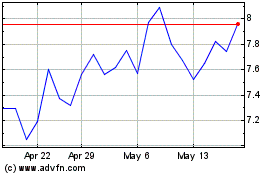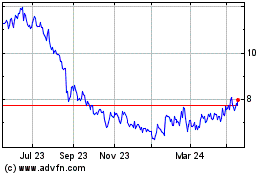By Rhiannon Hoyle
SYDNEY--Global miners including Rio Tinto PLC and Iluka
Resources Ltd. have long made a pile of profit from digging up a
sludgy commodity known as mineral sands, then shipping it to
countries such as China where it is used to whiten bathroom tiles
or in household paints.
Now, these miners are shooting to be at the forefront of
technological change--supplying the same commodity for use in 3-D
printing. They are working on ways to cut the cost of producing
titanium dioxide, the compound commonly produced from mineral
sands, and investing in technologies that will make it more
attractive for the 3-D printing industry.
In doing so, they hope to protect profits from future swings in
demand for titanium dioxide. Prices of the mineral sand rutile have
fallen more than two-thirds from their peak in 2012, amid a
slowdown in the pace of demand from traditional users. That has
forced miners to slash output: Iluka--the world's second-biggest
producer of titanium dioxide, with mining facilities in the U.S.
and Australia--dug up 23% less raw rutile in the first nine months
of 2015 versus a year earlier. Rio Tinto, the No. 1 producer, has
closed furnaces in Canada and South Africa and says its global
operations are running at about 60% of their capacity.
3-D printing--also called additive manufacturing--offers great
potential to diversify the market for mineral sands. The technology
has transformed within a decade from a niche industry making
models, prototypes and smaller items such as hearing aids to one
that has attracted investments from companies including jet-engine
maker General Electric Co. and appliance giant Whirlpool Corp.
These manufacturers want stronger, more lightweight materials that
don't cost more than the ones that they currently use.
3-D printing involves slicing a digital image of an object into
thousands of layers, which printers then recreate one at a time in
plastic, metal or other materials. A powdered form of the chosen
material, such as titanium dioxide, is used to create the
three-dimensional object from a computer design. In the case of
titanium, the powder is melted layer by layer with a laser to
create the item.
While high costs to slow print speeds have constrained the 3-D
printing industry, there are signs of more rapid growth.
Consultancy Wohlers Associates Inc., based in Fort Collins, Co.,
predicts it to be worth US$21.2 billion in 2020, up from US$4.1
billion last year.
"It is potentially a turbocharger over time on demand for
titanium dioxide," said David Robb, Iluka Resources's managing
director.
The size of the market for 3-D printing powder--which includes
forms of titanium, as well as steel, cobalt and other raw
materials--is set to increase at a compound rate of 24% each year
through 2020 to be worth US$500 million, according to MicroMarket
Monitor, an India-based research company. It foresees 3-D printing
being increasingly adopted in the manufacturing of some components
used in the automobile and aerospace industries.
To be sure, 3-D printing currently accounts for a small segment
of the titanium-dioxide market and miners say it may be years
before it contributes to their profits in a big way. Nearly 90% of
titanium dioxide produced goes into pigments for paints, paper and
plastics.
While mineral sands account for only a fraction of Rio Tinto's
profits compared with iron-ore sales, they are the main business of
the world's other top two suppliers, Iluka and Stamford, CT.-based
Tronox Ltd.
Iluka is diverting a portion of its mineral-sands output to an
industrial unit in Rotherham, a former steelmaking center in
northern England. There, scientists for closely held Metalysis are
testing a technology that they hope will simplify and dramatically
reduce the cost of producing titanium powder. Iluka, owns 18% of
Metalysis.
Rio Tinto is also "positioning ourselves on a technical side and
a production side" for a potential spurt in demand for 3-D printing
powder, said diamonds and minerals chief executive Alan Davies.
The mining giant has teamed up with The Natural Sciences and
Engineering Research Council of Canada and École de Technologie
Supérieure, an engineering school in Montreal, and is supporting
four other academic projects assessing the production of titanium
metal powders that could be used in 3-D printing, Mr. Davies
said.
Boeing Co., which already makes several hundred types of
aircraft parts using 3-D printing, including air duct components,
has been investigating a process called electron-beam melting, as
it works well with titanium.
Boeing said it is continuously reviewing 3-D printing methods,
believing the technology offers "the potential for widespread use"
to create titanium parts for its aircraft.
However, Boeing said titanium powder is currently much more
expensive than aluminum and steel, so there needs to be a strong
business case for it to replace those materials.
Still, Iluka says new planes tend to contain about three times
the titanium of older models.
"If you have a process that systematically changes out some of
the componentry or engines with a lighter and equally strong metal,
it is really a compelling case," said Rio Tinto's Mr. Davies.
Write to Rhiannon Hoyle at rhiannon.hoyle@wsj.com
Subscribe to WSJ: http://online.wsj.com?mod=djnwires
(END) Dow Jones Newswires
November 11, 2015 16:14 ET (21:14 GMT)
Copyright (c) 2015 Dow Jones & Company, Inc.
Iluka Resources (ASX:ILU)
Historical Stock Chart
From Dec 2024 to Jan 2025

Iluka Resources (ASX:ILU)
Historical Stock Chart
From Jan 2024 to Jan 2025
